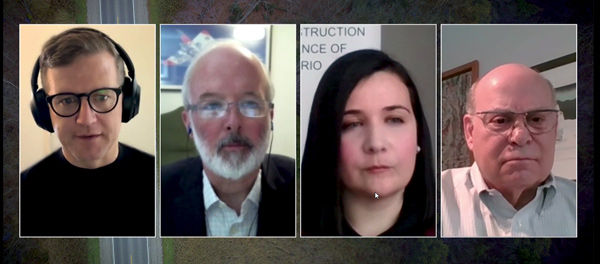Construction and engineering association leaders say they are cautiously optimistic about the outlook for this year, but there are uncertainties and obstacles to overcome before their members can start to build like they did pre-pandemic.
“Our member firms always deal with uncertainty in terms of project planning and the like but… the level of variability is so much higher than it has been in the past,” said Bruce Matthews, executive director for the Association of Consulting Engineering Companies (ACEC) – Ontario, during a panel at the virtual Ontario Good Roads Association conference Feb. 23.
“That is a conundrum that all of us really have to face is the extent of the unknown, because the crisis continues to extend beyond anyone’s expectations. I think everyone’s chomping at the bit to move forward.”
Industry still seeing decrease in tenders and projects
Nadia Todorova, interim executive director with the Residential and Civil Construction Alliance of Ontario, said members started 2020 strong with a backlog of work but have seen a precipitous drop of infrastructure tenders coming down the pipeline.
“COVID hit and there were issues on the municipal side in terms of the operating constraints that a lot of municipalities were facing which really presented a lot of challenges for our industry and really has impacted the volume of work coming down the pipeline over the last several months,” Todorova said. “There are challenges that need to be addressed before we can continue to build as much as we have in the past.”
Governments need to do more to address the issues municipalities are facing or it will have “disastrous” consequences for the industry and the province’s economic recovery, said Todorova.
“Municipalities are facing a lot of the same operating pressures and unless the federal government comes to the table with another Safe Restart Agreement for 2021, similar to what they did in 2020, with that specific funding for municipalities to help them address their operating pressures, our industry is going to be in trouble,” stated Todorova. “Municipalities are going to significantly decrease their spending and then take money from their capital budgets to address those pressures.”
Based on a survey of ACEC – Ontario member firms last fall, part of the membership has also noted a downturn in municipal projects.
“The larger municipality tends to be the larger the project, the more certainty there is about the continuation of work going forward,” said Matthews. “The concern about fewer public sector opportunities was actually higher among the larger firms who serve the large municipalities.”
Different approaches being implemented
Mark Romoff, president and CEO of the Canadian Council for Public-Private Partnerships, said there are many reasons to be positive about the year ahead, including infrastructure funding commitments from all levels of government.
In addition, the Canada Infrastructure Bank is focused on ways to collaborate with municipalities.
“I’m hoping that will lead to more encouraging levels of activity at the municipal level,” he noted. “The bank is dedicating $1 billion towards Indigenous infrastructure projects. That I think is a very much of interest at the municipal level.”
Although P3s have had great results in Ontario and across the country, other procurement and financing models are being considered by agencies like Infrastructure Ontario and Metrolinx. “One thing we’ve be seeing over the last couple of months and I think it is in part driven by the realities of COVID is there is more flexibility on the part of procurement agencies to explore new and different models,” said Romoff. “The Alliance model, Integrated Project Delivery, construction management, these are all different approaches to bring projects successfully to market.”
Another positive development is a commitment to unsolicited proposals.
“The private sector will be given the chance to make a proposal to governments and that will lead to more opportunities and at the same time to more innovative approaches to tackle the big infrastructure challenges that Ontario and other parts of Canada are confronting,” Romoff said.
Shovel worthy and shovel smart projects
Matthews said his organization’s philosophy is to put a focus on “shovel worthy” projects.
“These are projects that may not create construction jobs in the next six months but it allows planning work and design work to get underway for construction that may take place six, nine, 12 months from now,” said Matthews. “Ultimately it provides long-term economic stimulus to the municipality or to the province generally.”
Romoff added the council is discussing “shovel smart” projects.
“We want to make sure that governments are investing in projects that are really going to have an impact on the long-term plans for economic recovery,” said Romoff. “You want to make sure you put in place projects that are going to grow the GDP, going to create good quality jobs and at the same time of course really enhance productivity and in the case of Ontario their own global competitiveness.”
Follow the author on Twitter @DCN_Angela.











Recent Comments
comments for this post are closed